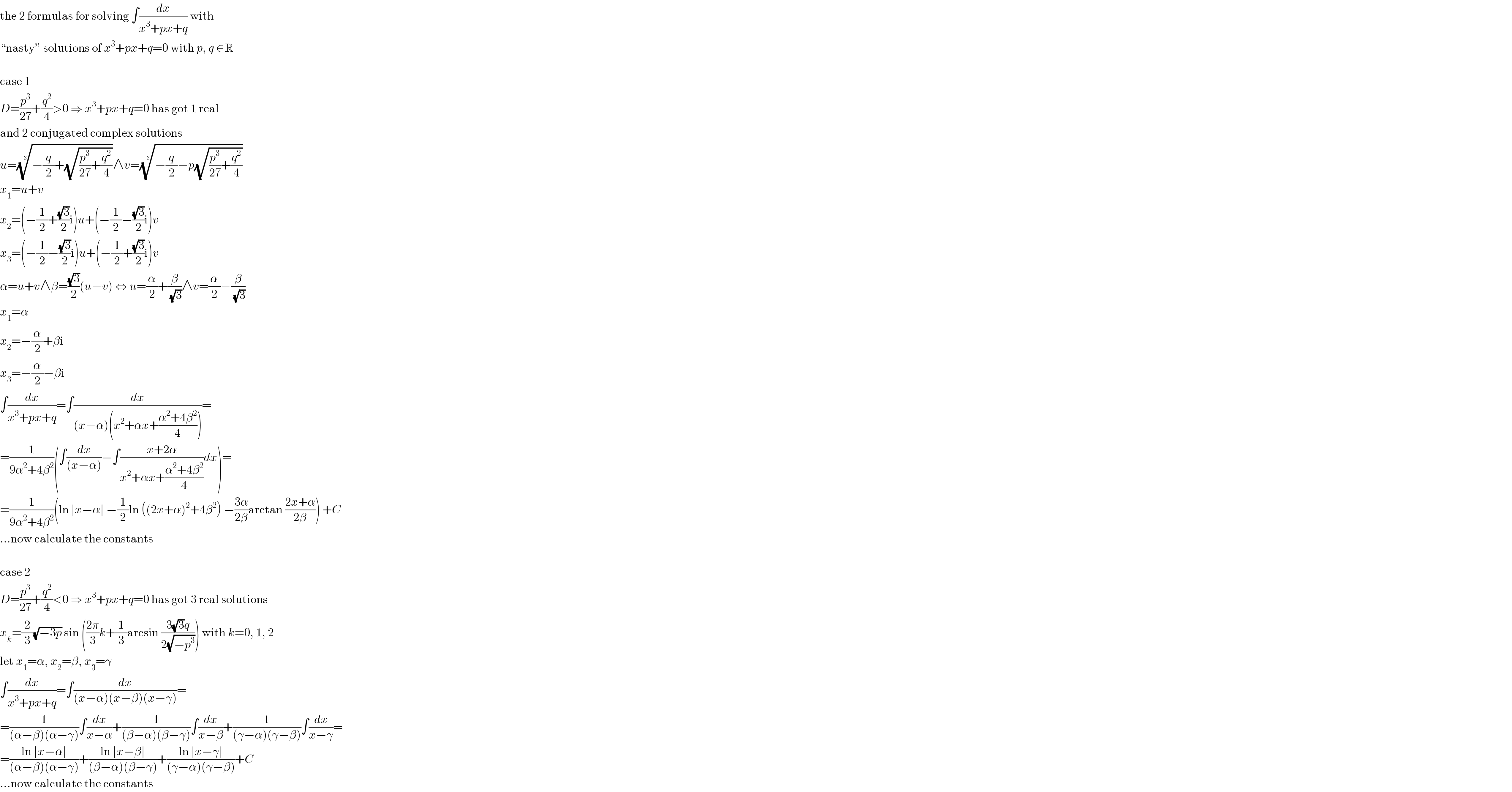
Question Number 68141 by MJS last updated on 06/Sep/19

$$\mathrm{the}\:\mathrm{2}\:\mathrm{formulas}\:\mathrm{for}\:\mathrm{solving}\:\int\frac{{dx}}{{x}^{\mathrm{3}} +{px}+{q}}\:\mathrm{with} \\ $$ $$\natural\mathrm{nasty}\varepsilon\:\mathrm{solutions}\:\mathrm{of}\:{x}^{\mathrm{3}} +{px}+{q}=\mathrm{0}\:\mathrm{with}\:{p},\:{q}\:\in\mathbb{R} \\ $$ $$ \\ $$ $$\mathrm{case}\:\mathrm{1} \\ $$ $${D}=\frac{{p}^{\mathrm{3}} }{\mathrm{27}}+\frac{{q}^{\mathrm{2}} }{\mathrm{4}}>\mathrm{0}\:\Rightarrow\:{x}^{\mathrm{3}} +{px}+{q}=\mathrm{0}\:\mathrm{has}\:\mathrm{got}\:\mathrm{1}\:\mathrm{real} \\ $$ $$\mathrm{and}\:\mathrm{2}\:\mathrm{conjugated}\:\mathrm{complex}\:\mathrm{solutions} \\ $$ $${u}=\sqrt[{\mathrm{3}}]{−\frac{{q}}{\mathrm{2}}+\sqrt{\frac{{p}^{\mathrm{3}} }{\mathrm{27}}+\frac{{q}^{\mathrm{2}} }{\mathrm{4}}}}\wedge{v}=\sqrt[{\mathrm{3}}]{−\frac{{q}}{\mathrm{2}}−{p}\sqrt{\frac{{p}^{\mathrm{3}} }{\mathrm{27}}+\frac{{q}^{\mathrm{2}} }{\mathrm{4}}}} \\ $$ $${x}_{\mathrm{1}} ={u}+{v} \\ $$ $${x}_{\mathrm{2}} =\left(−\frac{\mathrm{1}}{\mathrm{2}}+\frac{\sqrt{\mathrm{3}}}{\mathrm{2}}\mathrm{i}\right){u}+\left(−\frac{\mathrm{1}}{\mathrm{2}}−\frac{\sqrt{\mathrm{3}}}{\mathrm{2}}\mathrm{i}\right){v} \\ $$ $${x}_{\mathrm{3}} =\left(−\frac{\mathrm{1}}{\mathrm{2}}−\frac{\sqrt{\mathrm{3}}}{\mathrm{2}}\mathrm{i}\right){u}+\left(−\frac{\mathrm{1}}{\mathrm{2}}+\frac{\sqrt{\mathrm{3}}}{\mathrm{2}}\mathrm{i}\right){v} \\ $$ $$\alpha={u}+{v}\wedge\beta=\frac{\sqrt{\mathrm{3}}}{\mathrm{2}}\left({u}−{v}\right)\:\Leftrightarrow\:{u}=\frac{\alpha}{\mathrm{2}}+\frac{\beta}{\sqrt{\mathrm{3}}}\wedge{v}=\frac{\alpha}{\mathrm{2}}−\frac{\beta}{\sqrt{\mathrm{3}}} \\ $$ $${x}_{\mathrm{1}} =\alpha \\ $$ $${x}_{\mathrm{2}} =−\frac{\alpha}{\mathrm{2}}+\beta\mathrm{i} \\ $$ $${x}_{\mathrm{3}} =−\frac{\alpha}{\mathrm{2}}−\beta\mathrm{i} \\ $$ $$\int\frac{{dx}}{{x}^{\mathrm{3}} +{px}+{q}}=\int\frac{{dx}}{\left({x}−\alpha\right)\left({x}^{\mathrm{2}} +\alpha{x}+\frac{\alpha^{\mathrm{2}} +\mathrm{4}\beta^{\mathrm{2}} }{\mathrm{4}}\right)}= \\ $$ $$=\frac{\mathrm{1}}{\mathrm{9}\alpha^{\mathrm{2}} +\mathrm{4}\beta^{\mathrm{2}} }\left(\int\frac{{dx}}{\left({x}−\alpha\right)}−\int\frac{{x}+\mathrm{2}\alpha}{{x}^{\mathrm{2}} +\alpha{x}+\frac{\alpha^{\mathrm{2}} +\mathrm{4}\beta^{\mathrm{2}} }{\mathrm{4}}}{dx}\right)= \\ $$ $$=\frac{\mathrm{1}}{\mathrm{9}\alpha^{\mathrm{2}} +\mathrm{4}\beta^{\mathrm{2}} }\left(\mathrm{ln}\:\mid{x}−\alpha\mid\:−\frac{\mathrm{1}}{\mathrm{2}}\mathrm{ln}\:\left(\left(\mathrm{2}{x}+\alpha\right)^{\mathrm{2}} +\mathrm{4}\beta^{\mathrm{2}} \right)\:−\frac{\mathrm{3}\alpha}{\mathrm{2}\beta}\mathrm{arctan}\:\frac{\mathrm{2}{x}+\alpha}{\mathrm{2}\beta}\right)\:+{C} \\ $$ $$...\mathrm{now}\:\mathrm{calculate}\:\mathrm{the}\:\mathrm{constants} \\ $$ $$ \\ $$ $$\mathrm{case}\:\mathrm{2} \\ $$ $${D}=\frac{{p}^{\mathrm{3}} }{\mathrm{27}}+\frac{{q}^{\mathrm{2}} }{\mathrm{4}}<\mathrm{0}\:\Rightarrow\:{x}^{\mathrm{3}} +{px}+{q}=\mathrm{0}\:\mathrm{has}\:\mathrm{got}\:\mathrm{3}\:\mathrm{real}\:\mathrm{solutions} \\ $$ $${x}_{{k}} =\frac{\mathrm{2}}{\mathrm{3}}\sqrt{−\mathrm{3}{p}}\:\mathrm{sin}\:\left(\frac{\mathrm{2}\pi}{\mathrm{3}}{k}+\frac{\mathrm{1}}{\mathrm{3}}\mathrm{arcsin}\:\frac{\mathrm{3}\sqrt{\mathrm{3}}{q}}{\mathrm{2}\sqrt{−{p}^{\mathrm{3}} }}\right)\:\mathrm{with}\:{k}=\mathrm{0},\:\mathrm{1},\:\mathrm{2} \\ $$ $$\mathrm{let}\:{x}_{\mathrm{1}} =\alpha,\:{x}_{\mathrm{2}} =\beta,\:{x}_{\mathrm{3}} =\gamma \\ $$ $$\int\frac{{dx}}{{x}^{\mathrm{3}} +{px}+{q}}=\int\frac{{dx}}{\left({x}−\alpha\right)\left({x}−\beta\right)\left({x}−\gamma\right)}= \\ $$ $$=\frac{\mathrm{1}}{\left(\alpha−\beta\right)\left(\alpha−\gamma\right)}\int\frac{{dx}}{{x}−\alpha}+\frac{\mathrm{1}}{\left(\beta−\alpha\right)\left(\beta−\gamma\right)}\int\frac{{dx}}{{x}−\beta}+\frac{\mathrm{1}}{\left(\gamma−\alpha\right)\left(\gamma−\beta\right)}\int\frac{{dx}}{{x}−\gamma}= \\ $$ $$=\frac{\mathrm{ln}\:\mid{x}−\alpha\mid}{\left(\alpha−\beta\right)\left(\alpha−\gamma\right)}+\frac{\mathrm{ln}\:\mid{x}−\beta\mid}{\left(\beta−\alpha\right)\left(\beta−\gamma\right)}+\frac{\mathrm{ln}\:\mid{x}−\gamma\mid}{\left(\gamma−\alpha\right)\left(\gamma−\beta\right)}+{C} \\ $$ $$...\mathrm{now}\:\mathrm{calculate}\:\mathrm{the}\:\mathrm{constants} \\ $$
Commented bymind is power last updated on 06/Sep/19

$${thank}\:{you}\:{for}\:{this}\:{worck}! \\ $$
